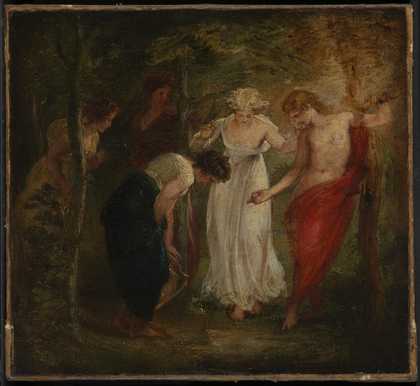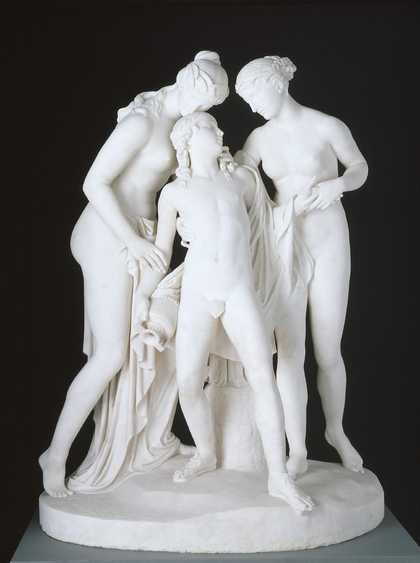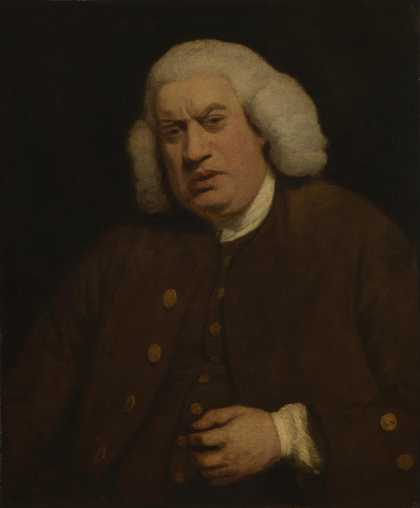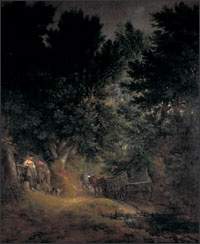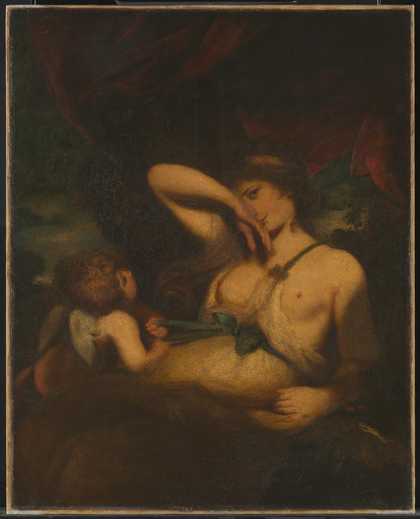
Sir Joshua Reynolds
A Nymph and Cupid: ‘The Snake in the Grass’ (exhibited 1784)
Tate
In the summer of 1784, Joshua Reynolds exhibited A Nymph and Cupid (Fig.1) at the Royal Academy’s annual exhibition. This work stood out because, unlike Reynolds’s fifteen other works on display, it was a portrait not of a prominent living individual but of an anonymous mythological creature. Visitors delighted in the nymph’s unusual pose and coquettish gaze. As one reviewer put it, the ‘power’ of the one visible eye is ‘doubled’ by the arm that conceals the other. An unresolved oscillation between the poles of visible and invisible, modesty and immodesty, is the real subject of this painting. As Reynolds pointed out, the figure is only ‘half-consenting’ to the spectator’s enjoyment of her semi-naked torso.
This nymph gave form to conceptions of erotic imagination that, in Britain during the closing decades of the 18th century, began to enjoy a new-found cultural legitimacy. Popularised in many print reproductions, the sensuality of Reynolds’s painting set a precedent for an art rooted in the hidden world of passion. In a period of revolution and conflict, it was images like this, and the figure of the nymph more generally, that were placed in opposition to art marked by contemporary realities.
Around the time of the 1784 exhibition, the long-established understanding that history painting ought to perform a moral function was starting to disintegrate. Offering a beauty that celebrated the body as a site of pleasure, the nymph’s symbolism was morally ambiguous. She stood as the antithesis of reason, rationality, heroism and monumental representations of antiquity. This kind of classicism could be aligned with physical experiences instinctive in all humankind, at least theoretically so. While still an ancient character and thus elevated above mortal flesh, the nymph allegorised the naturalness of desire and the sexual sensitivity of the mind.
During this period the idea of the erotic imagination emerged, influenced by contemporaneous medical literature as well as art, poetry and music. While in European culture the nymph had long functioned as a pastoral stereotype in the representation and idealisation of otherwise illicit themes, in late 18th- and early 19th-century Britain she acquired a distinct meaning which Bodies of Nature seeks to illuminate.
Nymphs and nymphomania
Today, the idea of the nymphomaniac may be more familiar than the nymph of classical mythology. Nymphomaniac, Danish director Lars von Trier’s recent two-part film, has been criticised for its graphic portrayal of female sex addiction. Von Trier suggests that there is no nymph in nymphomaniac, that the subtle, complex and dynamic significance of the former term has been drained from popular understandings of the disorder he takes for his title.
When, in 1771, a short book entitled La Nymphomanie, ou Traité de la fureur utérine was first published in Amsterdam the imagination was credited as the main cause of uncontrollable sexual urges in women, from ‘debauched girls’ to ‘married women’ and ‘young widows’. Written by French physician J.D.T. de Bienville, this quasi-scientific book, the first full-length discussion of female desire gone awry, argues that nymphomania begins in the mind, and is thus shrouded in secrecy. It ‘lurks’, writes the author, ‘under the imposing outside of an apparent calm, and frequently hath acquired a dangerous nature, when not only its progress, but its beginnings elude our perception.’ This ‘disease’ was thought to operate in terms similar to the nymphs of pagan Greek theology: by evading sight and blurring the line between imagination and reality. As alluded to in the writings of Plato and other classical authors, if mortal man happened to catch a glimpse of a nymph he might catch nympholepsy, a kind of epileptic frenzy not unlike the final stages of de Bienville’s nymphomania. Where von Trier is explicit enough to meet the demands of increasingly desensitised audiences, de Bienville before him was fixated on the unseen, the interior of the body, what occurs beneath the surface of the tangible.
De Bienville’s emphasis on the imagination influenced approaches to the concept of erotic feeling in and beyond the late-18th and early-19th nineteenth centuries. An English version of de Bienville’s text appeared in London in 1775, translated by Edward Sloane Wilmot, also a physician, under the title Nymphomania, or, a Dissertation Concerning the Furor Uterinus. Soon after publication it was reviewed in several journals. Most critics were sceptical, one dismissing it as nothing more than a hypocritically racy ‘medical romance’. By the early-19th century, however, Nymphomania appears to have commanded more authority. In 1802, an author writing in The Scots Magazine referred to the publication as scientific evidence for the corruptibility of the imagination by literary romances. Along with ‘amorous songs’, de Bienville had blamed ‘luxurious novels’ for inciting the passions and conjuring mental images that could cause insanity. Bienville’s book seems to have lent a scientific basis to the notion that the imagination, particularly that of the vulnerable female, could be sexually aroused by external stimuli. In the years surrounding the publication of this text, scientific writing remained reliant on poetic language: the flourishes and fancy soon to be confined to literature. In turn, de Bienville’s argument contributed to the question of how sexual desire could be represented in works of art.
The aroused imagination is the subject of Francis Chantrey’s Reclining Nymph c.1820–30, a small clay model in which a naked female figure lounges on a couch. In the context of portrait busts, funerary and honorific monuments dedicated to public figures in a naturalistic style, this statuette is an unusually intimate work for Chantrey. Gazing outwards and upwards into the space in which fantasies are fulfilled, the nymph appears to be in a trance. Her pose is similar to that of the courtesan in Titian’s Venus of Urbino, a work with which Chantrey would have been familiar, though the clay nymph does not betray the painted figure’s awareness that she is being watched and her body enjoyed by the spectator. Chantrey’s nymph could be the subject of a case study included in de Bienville’s Nymphomania.
G.S. Rousseau notes that attempts to address the role of the imagination were common by the time de Bienville’s text was published and first translated into English. Presenting sexual arousal as ‘a province of the imagination’, and writing exclusively about women, the author broke new ground. Though he was not the first to use the word ‘nymphomania’, de Bienville was a forerunner of sexologists such as Richard Kraft-Ebing and Havelock Ellis who incorporated the term into the textbooks they published at the turn of the century. By this time, nymphomania was widely understood as a psychological state detached from its namesake, the nymph. As a result, some scholars are reluctant to acknowledge any relationship between nymphs and the history of sex addiction. While the Greek word numphê can be translated as ‘bride’ or any nubile female (and at one point was also used to refer to the female genitalia), the semi-divine females of mythology who inhabit all areas of the natural world are defined by their association with sexual acts. The mythological nymphs in art and literature, ancient and modern, fed the etymology of the condition. The fact that the (infrequently diagnosed) male equivalent of nymphomania was named ‘satyrisasis’ after the satyr, the nymph’s traditional counterpart in the pastoral milieu, indicates the pertinence of such representations. Although de Bienville does not mention the nymph, he does not need to. Her significance is already entrenched in his choice of subject.
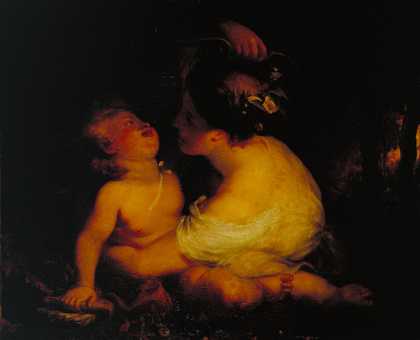
William Hilton the Younger
Cupid and Nymph (exhibited 1828)
Tate
In ancient texts and objects the nymph could either be the chaste object of an unbridled male libido – of Apollo or a satyr – or herself sexually promiscuous. This instability contributed to the sense of moral ambiguity in the nymph’s appearance in art. In A Nymph and Cupid, Reynolds had capitalised on this instability, depicting both desired objectivity and desiring subjectivity. Paradoxically, the Cupid that unfastens the Nymph’s girdle lends a touch of innocence to the principal figure’s sensuality. The mischievous conduct of the same infant Love is the focus of both William Hilton’s Cupid and Nymph (Fig.2), exhibited in 1828 and William Etty’s The Dangerous Playmate (Fig.3), exhibited in 1933. While Etty’s title renders explicit the perilous consequences of female passion, Hilton’s nymph is portrayed confiscating Cupid’s weaponry to prevent the onslaught of amorous feeling, causing the work to become known after the artist’s death as The Stolen Bow.
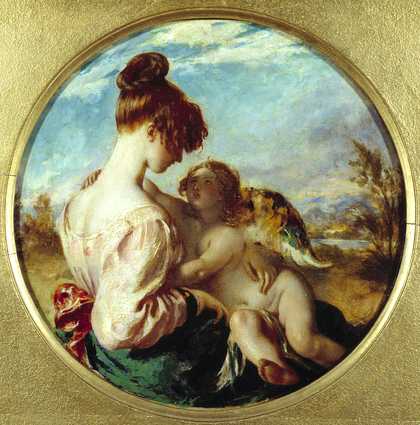
William Etty
The Dangerous Playmate (exhibited 1833)
Tate
Reynolds’s work differs from those of Hilton and Etty in that Cupid competes with a snake. Symbolic of lust’s danger, the snake is more insidious than Cupid’s arrow. When, in 1831, Reynolds’s work was exhibited for the third time at the British Institution, one journalist complained that the ‘snake and the Cupid have nothing in common’. It links the nymph to depictions of Cleopatra, a figure whose iconography was familiar to the artist. Although he did not include a snake in his small oil painting Cleopatra (Fig.4), Thomas Stothard depicts the Egyptian pharaoh as a nymph-like girl surrounded by floating putti that articulate her connection to sexual sentiments and experiences. Lying on a couch similar to Chantrey’s, Stothard’s figure fingers her skirt as if she is about to remove her gown to expose her naked body. This tiny nymph-Cleopatra, Reynolds’s A Nymph and Cupid and de Bienville’s Nymphomania each derive their power from what remains concealed, making it significant that Wilmot had translated de Bienville’s description of the condition as ‘a serpent which hath insensibly glided into her heart’.
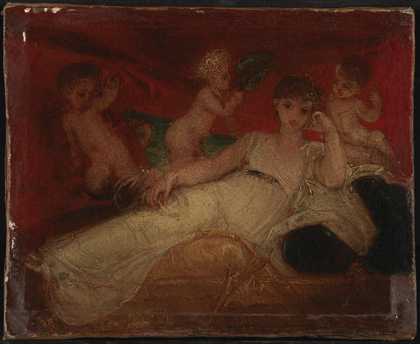
Thomas Stothard
Lady Reclining ()
Tate
Into the nymph’s imaginary
In Hilton’s Nature Blowing Bubbles to her Children (Fig.5 ), exhibited in 1821, an allegorical Nature, draped only to the waist, reclines on a bed of earth in a glade. She releases a soap bubble into the air while infant boys, her children, scramble over her to pop it before it bursts. In the distance, another group of boys can be seen chasing other bubbles. Nature’s breasts, and those of nymphs by Reynolds and Chantrey, are small and spherical like those in Graeco-Roman sculpture. The visual metaphor of bubble-blowing children is found in vanitas motifs in Dutch and Flemish still life and genre painting where it signifies the futility of earthly pursuits and the brevity of human life. Hilton’s work is the opposite of heroic history painting. Men are replaced by chubby toddlers, and their aspirations by a trivial game. In this image the artist exchanges moral instruction for a proclamation of carpe diem. If life on earth is fleeting and ambition a distraction, then enjoy Nature’s pleasures, embodied in the figure of the nymph.
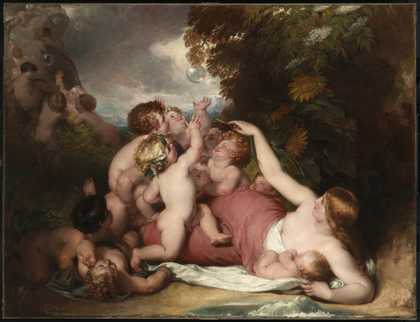
William Hilton the Younger
Nature Blowing Bubbles for her Children (exhibited 1821)
Tate
The nymph’s moral ambiguity can be seen as a template for classical art that rejects the Manichean model of good and evil, virtue and vice, a binary at the core of 18th-century discourses on history painting. Hilton’s Nature assumes god-like authority, sanctioning hedonistic enjoyment and freedom from social constraints or domestic mores. The children’s game takes place outside linear time. The spectator is confronted with what Michel Maffesoli describes as ‘a poetic and erotic time, a time of the amorous body’, as opposed to the ‘historic time’ of preconceived narratives and identities, politics and ideology. Reynolds was Hilton’s primary influence, and it was in A Nymph and Cupid that he dramatised this mode of imaginary time. The fact that Reynolds’s principal figure is seen at the moment when the hidden parts of her body are in the process of being unveiled makes this a transitory image without beginning or end.
In December 1786, Reynolds gave a lecture to students of the Royal Academy that overturned his previous directives always to adhere to the rules of art as laid out by the greatest of classical and old master works. He now insisted on the primacy of intuitive emotion in the production and consumption of art, stating that ‘Reason, without doubt, must ultimately determine every thing; at this minute it is required to inform us when that very reason is to give way to feeling.’ Like de Bienville, Reynolds renders feeling a department of the imagination. Unconcerned with progress, this new theory of art favours pleasure over technical improvement. The alternative mode of time it glorifies cannot be verbally articulated, and it is only with recourse to an abstract golden age that Reynolds is able to describe it: with the help of the senses, it is art’s duty to transport the ‘mind…beyond the ignorant present, to ages past’. Imagination now forms the rubric of perfection. It converts the ‘gross state of nature’ into something beautiful and potentially ‘divine’, like Hilton’s allegorical mother figure.
In his subsequent lecture, delivered in 1788, Reynolds posited his recently-deceased contemporary Thomas Gainsborough as the artist who typified the downgrading of reason in favour of the imagination and the senses. Gainsborough’s A Nymph at the Bath c.1780 (Fig.6), later known as Musidora (after James Thompson’s nymph-heroine in his 1730 cycle of poems The Seasons) is an example of the ‘painterly painting’ that Reynolds considered key to Gainsborough’s command over the emotions. It depicts a seated figure, with russet hair and sunlit breasts, which adheres to the ideal of marble femininity. Her draped body is the site at which revelation and restriction intersect. Anne Bermingham refers to its voyeuristic quality, but this is only half the story. The spectator is invited to gaze at the nymph as she turns away. Yet in this voyeuristic position the viewer does not simply delight in the spectacle of a half-naked female form, but encounters the non-linear time and place this figure shares with Reynolds’s nymph and Hilton’s Nature. As with Nature Blowing Bubbles to her Children, Gainsborough’s work includes a relatively developed background to emphasise the sense of entering into an alternative order, or dis-order. His nymph does not engage with the spectator, but is self-sufficient in her action: soaking one foot in the shallow pool, and catching the last rays of sunlight. Where Reynolds had relied on Cupid and the snake – cultural motifs that elicit an emotional response from the spectator – Gainsborough used landscape to generate the sense of human instinct that these works explore.
Gainsborough’s nymph gazes down, her lips slightly parted as if singing. Sound was important to Gainsborough, who was an accomplished musician. Though Amal Asfour and Paul Williamson do not mention this particular nymph they devote a chapter of their study of the artist to the notion that the formal properties of music offer a method for reconciling Gainsborough’s use of paint, what Reynolds called his ‘hatching manner’, with the emotional resonance of his works. Citing contemporaneous discourses on music in relation to other art forms, they show how, in theory, music’s appeal was thought to reside in its access to the listener’s sensibility. It is the art of effect and impressionistic re-creation over imitation. In his 1786 lecture, Reynolds had conceived of music as an art that ‘applies itself…directly to the imagination’, and in his ensuing treatise on Gainsborough, he stressed that the ‘uncouth and shapeless appearance’ of the latter’s forms converts into beauty by way of a ‘magic’ that occurs in the mind of the spectator. Gainsborough’s nymph is both formally and symbolically akin to the ‘amorous songs’ that de Bienville claimed could foster desire. The effects of music provide a shortcut to the nymphs created by Reynolds and Gainsborough, Hilton, Chantrey and Stothard.
War and the poetic cult of the nymph
In his two-part poem ‘The Commemoration of Reynolds’, future Academy president Martin Archer Shee begins by acknowledging the negative impact of war on art, something that his predecessor is held to have been able to overcome. Reflecting twenty-two years after Reynolds’s death from the war-torn vantage point of 1814, Shee conjures the chaos of ‘a world in arms’, with ‘ravaged Nature’ moaning as ‘monarchs tremble on their tottering thrones’, foreshadowing the ‘slaughter’ and floods of ‘human gore’ that have afflicted Europe. Privileging the feminised beauties of art over its potential moral, monumental or documentary purposes, he asks, ‘What gentle voice of Muse or Grace around—What Syren song in such a storm can sound?’ Instead of providing insight into Reynolds’s relationship to the wars that broke out during his lifetime, chiefly the Seven Years War and the War of American Independence, the opening part of ‘The Commemoration’ is rooted in the ravages of the Revolutionary and Napoleonic Wars that shaped the writer’s career. Shee invokes Reynolds’s more pleasurable classical style, epitomised by A Nymph and Cupid, as a mode of escape from the war-torn present. Reynolds is imagined as the master of an eroticised dream-world in which he freely wanders in ‘flowery groves, where blooming nymphs recline in green alcoves’ and is later led by Venus to ‘secret bowers’ where he catches ‘some nymph divine, in every shade’. The Cupid-like figure in Shee’s A Young Bacchus (Fig.7), exhibited in 1824, follows the precedent set by the hedonistic works that he here admires. The poem reveals that, for Shee, this type of painting was explicitly opposed to lived reality.
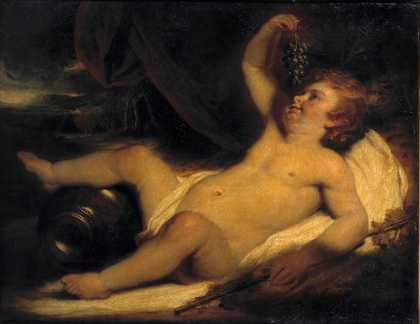
Sir Martin Archer Shee
A Young Bacchus (exhibited 1824)
Tate
At this time of war, the appeal of the nymph in contemporary academic artistic practice was overshadowed by monumental antiquity and its allegories with meanings that her sensuality threatened to unravel. Certain artists, however, such as another of Reynolds’s admirers Richard Westall, remained committed to the nymph in spite of her irrelevance to the political project. Although Thomas Stothard, like Westall, is today remembered mainly for his literary illustrations, his paintings of classical scenes were valued during his lifetime, and were incorporated into what became, throughout the 1820s, a fully-fledged cult of the nymph, subscribed to by poets such as Leigh Hunt, John Keats and Percy Bysshe Shelley. They made the nymph the symbolic figurehead of their pleasure-seeking, Nature-deifying world view, an approach to art and life often bracketed under the category of ‘romanticism’.
Stothard’s version of antiquity was not that of the serene marble gods and goddesses that informed countless designs for war monuments during his lifetime, but the energetic and emotive side of classicism. Of the generation between Reynolds and Gainsborough and Hilton, the post-war years were Stothard’s most successful. Nymphs and nymph-like forms featured frequently in his work.
While literary critics have studied the nymphs in contemporaneous poems by Hunt and Keats in particular, the impact of Stothard on their brand of classical engagement has scarcely been acknowledged. The continuity between the painter (who was older than the poets) and the cult of the nymph begins with Hunt’s 1818 Foliage, a collection of poems presented as a manifesto. Editor of the liberal journal The Examiner, Hunt was at the centre of the London literary scene, counting Shelley and Lord Byron among his friends and was a mentor to Keats. Following Napoleon’s defeat, Hunt stepped back from overt political engagement to focus on the beauty and potential of life on earth rather than the dream of civic reform he had long championed. In the preface to Foliage, Hunt calls the ‘properties of poetry’ the ‘sensitiveness to the beauty of the external world, to the unsophisticated impulses of our nature, and above all, imagination, or the power to see, with verisimilitude, what others do not’. Like de Bienville, Reynolds and Gainsborough, Hunt extols the ability to view what is hidden, so that disclosure becomes a legitimate form of comprehending human nature and converting this nature into beauty.
Hunt suggests that this new type of writing has overturned the previous (revolutionary and war-torn) era’s poetic convention: ‘its cold and artificial compositions have given way, like so many fantastic figures of snow; and imagination breathes again in a more green and genial time’. He is open about the fact that his withdrawal into ‘the fair forms and leafy luxuries of ancient imagination’ is a reaction to the recent ‘political convulsions of the world’. Hunt opens the volume with a two-part poem entitled ‘The Nymphs’, a work that Shelley would go on to praise as ‘truly poetical in the intense and emphatic sense of the word’. Although Hunt did not know him personally (as he did Hilton and the subjects of his other dedicatory verses), Foliage ends with a short poem, ‘To Thomas Stothard R.A.’.
For Hunt, an advocate of women’s education and equality, the nymph was far more than a locus of clandestine desires. His nymphs are capable of greatness as well as, or rather in addition to, objective and subjective pleasure. They are
Etherial human shapes, perhaps the souls
Of poets and poetic women, staying
To have their fill of pipes and leafy playing.
These nymphs signify interpersonal contact beyond the boundaries of sociality; they fill the speaker’s ‘solitude with panting tongues’. Hunt’s ‘The Nymphs’ evokes erotic liberty as a substitute for political freedom, the potential attainment of which, at the time of composition, seemed a distant prospect. Hunt’s commitment to everything his nymphs stand for becomes explicit at the beginning of the second part, when these beings move in a militaristic formation as ‘a pomp of warriors’. The fight for free love is a cause no less noble than the will to political change, and infinitely more attainable.
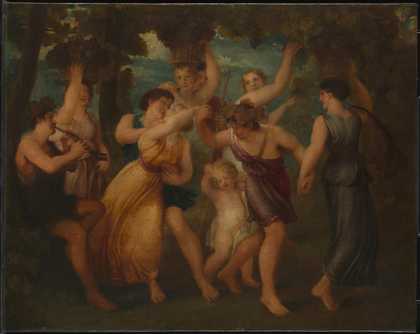
Thomas Stothard
The Vintage (exhibited 1821)
Tate
Stothard’s paintings fascinated Hunt because they were thought to capture femininity in its complexity, and Hunt called Stothard a master of ‘the true woman’s gentle mien divine’. His paintings shared Hunt’s departure from the idea of the nymph as a being defined only through her sexual connotations. Stothard was considered an artist who could depict erotic themes and subjects with propriety. An article in The Literary Chronicle and Weekly Review discussing his 1821 Nicolas Poussin-esque The Vintage (Fig.8), a lively Bacchanalian scene of dancing and embracing ‘nymphs and swains’, appreciated how the painter had
converted a scene which former painters always rendered disgusting, into one of delicacy; and, instead of representing the ‘Vintage’ as a scene of drunkenness and vulgarity, has made it moral and instructive… Bacchus is not the loathsome being he has hitherto been represented, but the beautiful god of the Greeks.

Thomas Stothard
Intemperance: Mark Antony and Cleopatra (c.1802, ?exhibited 1805)
Tate
In a catalogue of pictures amassed by the collector Robert Vernon, another writer discusses Stothard’s orgiastic Intemperance (Fig.9), another portrayal of Cleopatra, this time with her lover Mark Antony. Populated by naked nymphs engaged in various amorous activities, the painting is described as ‘full of poetical feeling, which…is certainly free from that offensive vulgarity that a less delicately moulded spirit than Stothard’s would possibly have thrown into such a scene’. Stothard’s familiar manner functioned as a veil over otherwise lascivious subjects. This is similar to Hunt’s idealisation of passion and his desire to afford eroticism the sanctity of a religion, something suggested, too, in the divine authority of Hilton’s Nature. In Hunt’s poem dedicated to the artist, Stothard is pictured in a bower among ‘fair things, clear as the lily flowers’; though he does not use the word ‘nymph’, her presence is implicit.
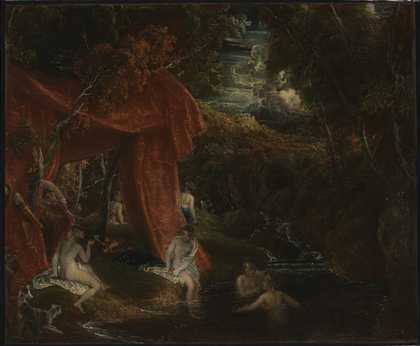
Thomas Stothard
Diana and her Nymphs Bathing (exhibited 1816)
Tate
Hunt owned prints after Stothard’s The Vintage, Diana and her Nymphs (Fig.10) and other works by the artist. Keats biographer Sidney Colvin notes that the poet came into contact with these images, as well as engravings after Poussin’s erotic paintings, by seeing them ‘on Hunt’s walls and in his portfolios’. Colvin also speculates that the influence of Elizabethan poet Edmund Spenser on Keats’s classicism was mediated by ‘Stothard’s sugared illustrations’ to his Fairie Queene, an epic poem in which nymphs are present. The primacy of the nymph in Keats’s poems, such as Endymion (1818) and Lamia (1820), as well as the ‘dryad’ in Ode to a Nightingale (1819), was criticised by the rural poet John Clare, who complained of Keats’s ‘constant allusion or illusion to the grecian mythology’ found in the ‘dryads & fawns’ and ‘naiades’ that often accompany his evocations of outdoor scenery. In his Essay on Landscape, Clare had attacked the tendency for painting to represent the natural world as ‘crowded with groups of satyrs & fawns & naiads & dryads & a whole catalogue of vampire unaccountables dancing about in ridiculous situations’, something that points to the impression made by Stothard and Westall, as well as Poussin, whose legacy was fashionable at this time. George Frederic Watts’s Nymphs and Satyrs (Fig.11) and The Golden Age (Fig.12), both c.1840, show such influences.
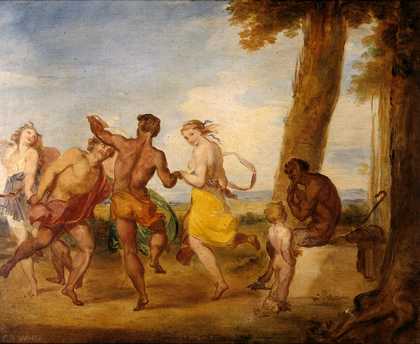
George Frederic Watts
Nymphs and Satyrs (c.1840)
Tate
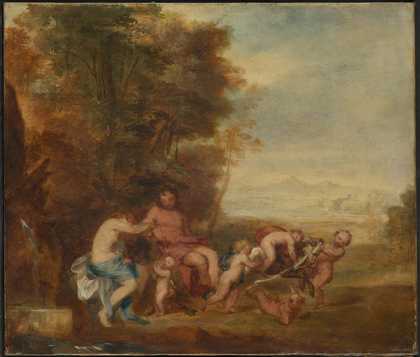
George Frederic Watts
The Golden Age (c.1840)
Tate
Clare was mistaken in his interpretation of Keats’s nymphs as mere supplements to nature. They embody human nature. Their associations with the natural world serve as a means by which erotic passion, encompassing sexual deviance and non-normative forms of desire, can be rendered natural by art. Stothard’s Cupid Bound 1787 (Fig.13) and Dryads Finding Narcissus 1793 (Fig.14) show groups of females illustrating desiring subjectivity. The leading role they assume in the satisfaction of desire anticipates Henry Howard’s Hylas and the Nymphs 1821 and John Gibson’s later marble group Hylas Surprised by the Naiades (Fig.15) exhibited in 1837. They share a focus on the nymph’s power, equal in strength to heroism. The poetic cult of the nymph found its philosophy consolidated in such works.
html PUBLIC "-//W3C//DTD HTML 4.0 Transitional//EN" "http://www.w3.org/TR/REC-html40/loose.dtd"
Conclusion
By the time Reynolds exhibited A Nymph and Cupid, the nymph had long represented sexual feeling in socially acceptable terms. The Idylls of Theocritus, Virgil’s Eclogues and other classical verses grounded the nymph’s status as the vehicle for an erotic expression that was, because classically ideal, protected from allegations of depravity. Sourcing its name from ancient culture, nymphomania (and its comparatively obscure male counterpart satyriasis) can be incorporated into the same historiography of the nymph found in works of art across the continent. However, the premium placed by de Bienville on the imagination developed the nymph’s potential beyond the conventional iconography of eroticism to stand for an alternative time and place that becomes visible only through artistic representation, but that is open to anyone capable of putting feeling above thought. In British art of the period, the un-reasonable nymph was prized for her distance from wartime art and its moral or partisan pressures.
The primacy each painting affords to the imagination helps counter the dismissal of these works as relics of a bygone era. The landscapes of J.M.W. Turner and John Constable, the genre scenes of David Wilkie, even the anomalous visions of William Blake, have come to stand in for the ‘romantic’ period in British art in the way that they anticipate aspects of the Pre-Raphaelite, realist and impressionist movements. In contrast, the painted and sculpted nymphs produced during the same period have been overlooked. As a result, artists such as Reynolds, Gainsborough, Stothard, Westall, Hilton, Howard and Watts have become less influential. Because of their depreciating worth and obscured significance (not to mention the artists’ material experiments), the condition of some of their paintings has deteriorated. Sections of canvas have been damaged, surfaces yellowed by aged varnish or darkened to a murky green. Yet their elusive world of passion can still be retrieved by seeing beyond the flaws and the immediately visible.
Reading list
Jean-Christophe Abramovici, ‘Eroticism’ in Encyclopedia of the Enlightenment, ed. Michel Delon, New York, 2013.
Amal Asfour and Paul Williamson, Gainsborough’s Vision, Liverpool, 1988.
Anne Bermingham, Landscape and Ideology: The English Rustic Tradition, 1740-1860, Berkeley and Los Angeles, 1986.
John Clare, ‘Essay on Landscape’ in J.W. and Anne Tibble (ed.), The Prose of John Clare, London, 1951.
Sidney Colvin, ‘Life of John Keats’ in The Delphi Complete Works of John Keats, ebook, 2012.
W.R. Connor, ‘Seized by the Nymphs: Nympholepsy and Symbolic Expression in Ancient Greece’, Classical Antiquity volume 7, October 1998.
J.D.T de Bienville, La Nymphomanie, ou Traité de la fureur uterine, Amsterdam, 1771.
Havelock Ellis, Studies in the Psychology of Sex, London, 1897.
Kurt W. Forster (ed.), The Renewal of Pagan Antiquity: Contributions to the cultural history of the European Renaissance, Aby Warburg, trans. David Britt, Los Angeles, 1999.
Leigh Hunt, Foliage: Or, Poems Original and Translated, London, 1818.
Richard Krafft-Ebing, Psychopathia Sexualis, trans. Francis J. Rebman, London, 1899.
Jennifer Larsen, Greek Nymphs: Myth, Cult, Lore, New York, 2001.
Michel Maffesoli, The Shadow of Dionysus: A Contribution to the Sociology of the Orgy, New York, 1993.
Corinne Odine Pache. A Moment’s Ornament: The Poetics of Nympholepsy in Ancient Greece, New York, 2010.
Martin Postle, Sir Joshua Reynolds: The Subject Pictures, Cambridge, 1995.
G.S. Rousseau, ‘Nymphomania, de Bienville and the rise of erotic sensibility’ in Paul-Gabriel Boucé (ed.), Sexuality in Eighteenth Century Britain, Manchester, 1982.
Martin Archer Shee, The Commemoration of Reynolds, in two parts, with notes and other poems, London, 1814
Anna Southall, ‘Emulation and Change: Some Materials and Practices in British Painting, 1750-1850’ in Sue-Anne Wallace (ed.), The Articulate Surface: dialogues between conservators, curators and art historians, Canberra, 1995.
Robert R Wark (ed.), Discourses on Art by Sir Joshua Reynolds, New Haven and London, 1975.
Edward Sloane Wilmot, Nymphomania, or, a Dissertation Concerning the Furor Uterinus, London, 1779.

